Covering 29,000 acres and boasting 233 miles of shoreline, Lake Lewisville is among the largest lakes in north Texas and a hub of outdoor activities. With its expansive waters, it warmly welcomes enthusiasts of fishing, skiing, boating, and swimming, offering a little something for everyone!
The fishing scene here is particularly vibrant, providing both seasoned and novice anglers an exciting opportunity to enjoy the natural abundance. As you cast your line into the waters, a variety of fish await beneath the surface, ready to provide a good challenge. Let’s explore the 15 types of fish you might catch in Texas’s Lake Lewisville.
1. Blue Catfish (Ictalurus furcatus)

One of the more common fish you may catch in Lake Lewisville is the blue catfish.
©Thomsonmg2000, cropped and adjusted by Kostka Martin / CC0 – License
First up on the list of fish you could catch in Lake Lewisville, Texas, is the blue catfish. You’ve got a solid chance of catching one, as they’re pretty abundant in this lake.
Blue catfish are distinguishable by their flat top fin and a tail that splits deeply. They sport a silvery-blue hue on their upper side and a white underside. Instead of scales, their skin is smooth. Around their mouth, they have four sets of dark, whisker-like feelers.
Most of these fish don’t get bigger than 2 feet, but some can reach lengths of up to 5 feet.
They usually stick to the bottom of large rivers with deep channels, quick water flows, and sandy floors. While blue catfish like fresh water, they can also survive in saltier conditions. They eat a variety of foods, such as frogs, clams, worms, tiny shellfish, crabs, mussels, bugs, and even other smaller fish, including their own kind.
2. Kelp Bass (Paralabrax clathratus)
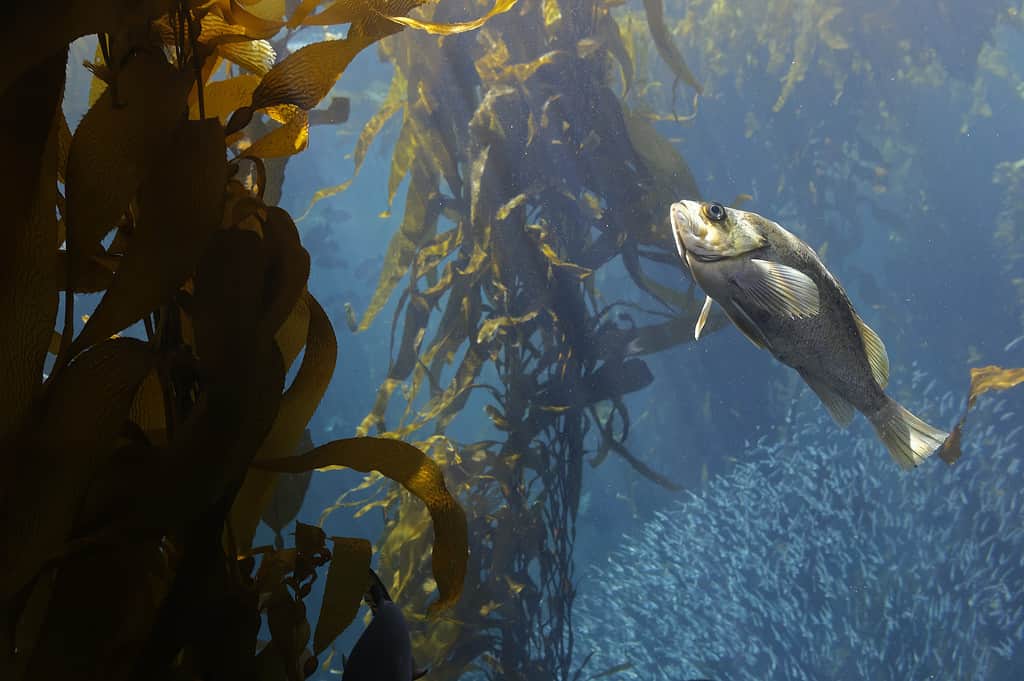
Kelp bass is less common in Lake Lewisville.
©Gilberto Villasana/iStock via Getty Images
Next on the list of potential catches in Lake Lewisville is the kelp bass. While not as prevalent as the blue catfish, your odds of hooking one are still pretty good.
Kelp bass are medium-built fish with elongated bodies and mouths that curve downward, giving them a somewhat sad appearance. They have brown or olive green backs adorned with white spots, yellow-tinted fins, and a white belly.
These fish can reach lengths of up to 28 inches.
You’ll usually find them lurking around shallow waters and kelp forests, going as deep as 70 feet. When hunting, kelp bass form groups to chase down schools of smaller fish, attacking from multiple directions and sometimes even jumping out of the water to catch their prey.
Contrary to their name, kelp bass don’t specifically need kelp to thrive. They’re happy to gather around any stable underwater feature, be it shipwrecks, boulders, underwater pipes, or wooden pilings.
3. Largemouth Bass (Micropterus salmoides)

Try your hand at catching largemouth bass in Lake Lewisville!
©Maclane Parker/Shutterstock.com
Another frequent find in Lake Lewisville is the largemouth bass.
These fish have a dark olive-green back that fades into lighter green sides and, eventually, a white underbelly. They have a distinct, dark stripe running along their flanks. Unlike their smallmouth bass cousins, the upper jaw of a largemouth bass extends beyond its eyes.
A typical largemouth bass measures around 12 to 24 inches.
You’ll often spot these fish in warm, shallow waters, either in small lakes or the shallower parts of bigger ones, usually near thick underwater plants.
Young largemouth bass primarily eats tiny aquatic organisms, bugs, and small fish. As they mature, their diet expands to include larger fish and crayfish, with sunfish often being a favorite meal. These fish are most active during feeding at dawn and dusk.
4. White Bass (Morone chrysops)
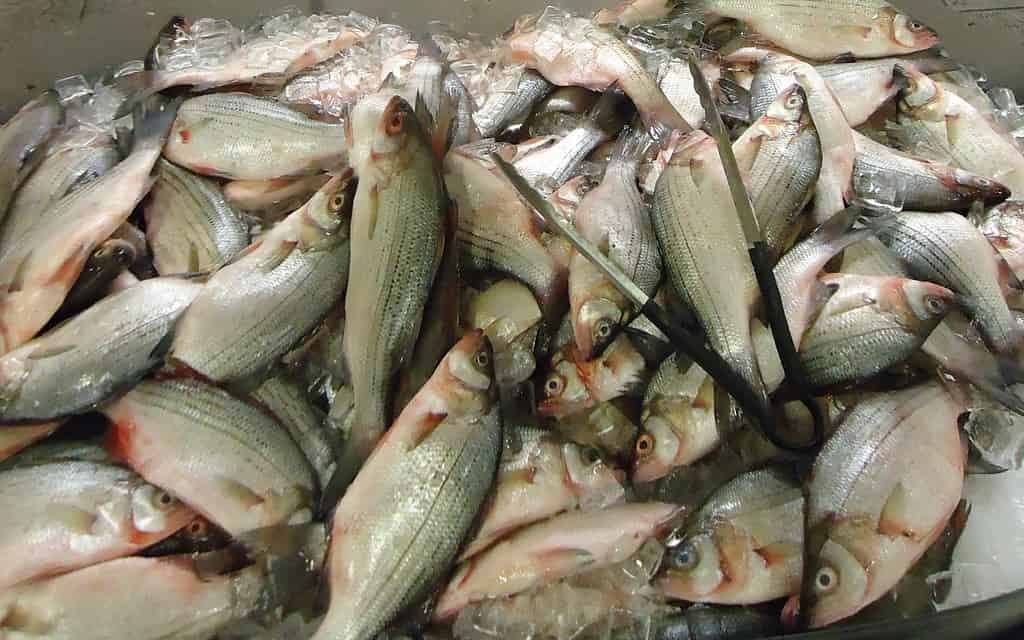
White bass swim around Lake Lewisville as well.
©Tomwsulcer / CC0 – License
Another popular and common fish you might encounter in Lake Lewisville is the white bass.
These fish resemble miniature striped bass, featuring a silvery-white body adorned with five to eight dark, uneven stripes along their sides. They’re more compact than striped bass, have a smaller head, and their dorsal fins sit closer to each other.
Typically, a white bass measures around 12.5 inches, but some have been reported to grow as long as 17.7 inches.
They usually hang out in big bodies of water like deep lakes or expansive rivers, particularly near dams. They steer clear of murky water and heavily vegetated areas. Young white bass mainly eat tiny water insects and small invertebrates, while the adults prefer smaller fish like threadfin shad for their meals.
5. Black Crappie (Pomoxis nigromaculatus)

The black crappie fishing is pretty good in this lake!
©Steve Oehlenschlager/Shutterstock.com
Just like white bass, the chances of catching black crappie are very high in Lake Lewisville as it is one of the most abundant fish in the lake
The black crappie features a silver-gray to white body covered with dark, almost black patterns. During mating season, they can appear mostly black, dotted with shimmering shades of blue and green. Their fins are often decorated with rows of dark markings.
On average, these fish are 10.8 inches in length.
Black crappies like to gather in groups and are usually most active in their search for food during the early morning hours. They prefer calm, warm waters that have lots of underwater plants and sandy or muddy floors. Their diet generally consists of small fish, tiny shellfish, and insect larvae.
6. Spotted Bass (Micropterus punctulatus)
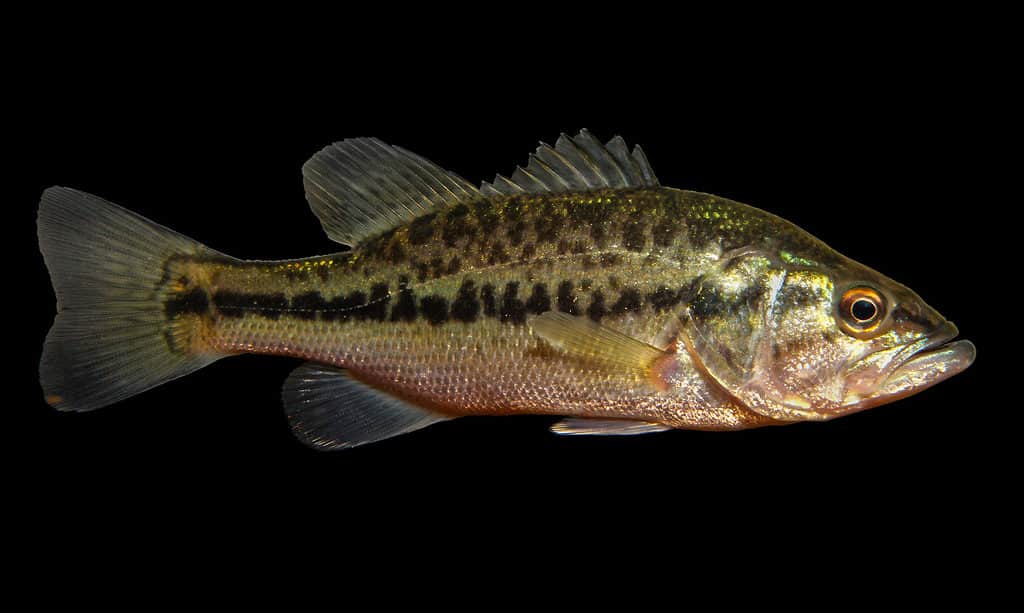
Spotted bass can grow up to 2 feet long.
©Sean McVey/Shutterstock.com
Catching a spotted bass in Lake Lewisville is more of a rarity, as they aren’t common.
While these fish share similarities with largemouth bass, spotted bass can be distinguished by a few key traits: they have scales on the lower part of their second dorsal fin, their two dorsal fins are directly connected, and their upper jaw doesn’t go past their eyes.
These fish can attain lengths close to 24 inches or 2 feet.
Spotted bass generally like clear, slow-moving water bodies with either gravel or rocky floors. They’re also found in clear lakes. They eat a mix of small fish, crayfish, and aquatic insects. Younger spotted bass begin their diet with small crustaceans, transitioning to insects as they grow.
7. Channel Catfish (Ictalurus punctatus)

If you’re after catfish, you might be able to hook in a channel catfish.
©Alauddin Abbasi/Shutterstock.com
Hooking a channel catfish in Lake Lewisville is about as easy as fishing gets.
These fish are easy to recognize by their tail fins, which are deeply forked, a feature they share only with blue catfish. They also have an upper jaw that juts out past the lower one. Their back and sides are usually olive-brown to slate-blue, transitioning to a silvery-white belly.
Usually, an adult channel catfish will measure at least 12 inches long.
These fish like warm waters, ideally at least 70°F, and are often found in various settings, including rivers, ponds, and swamps. These bottom-dwellers aren’t picky; their diet includes everything from insects and shellfish to small birds and snakes. The young fish are even more diverse eaters, consuming plant and animal-based foods.
8. Flathead Catfish (Pylodictis olivaris)
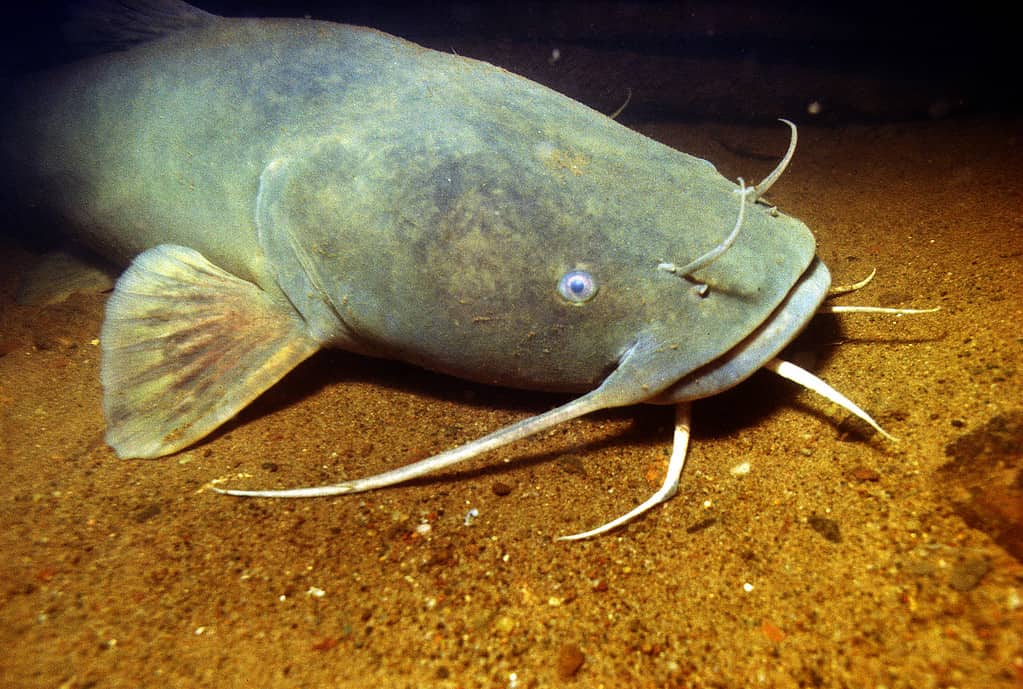
Flathead catfish are relatively common in Lake Lewisville as well.
©stammphoto/ via Getty Images
You won’t have a hard time reeling in flathead catfish in Lake Lewisville; they’re pretty plentiful in this lake.
Identifiable by their pale yellow to light brown coloration and often marked with dark patches, flathead catfish also have a distinctively broad and flat head with a protruding lower jaw. Their stomachs usually show a light yellow or creamy hue.
These fish can reach impressive sizes, often growing between 3 to 4 feet in length.
Flathead catfish prefer the deep sections of lakes, rivers, and other water bodies where the water is somewhat cloudy and the current is slow. As predators, their diet mainly consists of other fish like bass and shad, along with crayfish. Younger flatheads lean more towards a diet of water insects and crayfish.
9. White Crappie (Pomoxis annularis)

The white crappie generally measures less than a foot long.
©iStock.com/Jenniveve84
There are plenty of white crappie in Lake Lewisville, just like their black crappie cousins.
These fish typically have a grayish-green back that lightens to a silvery or brassy hue on the sides, finishing with a white belly. Adult white crappies sometimes have a slight pink tint on their chins.
They generally measure between 6 and 11 inches in length.
You’ll find white crappie mainly in murky, warm waters like lakes and rivers, especially in bodies of water that are more than 5 acres in size. In their early stages, these fish feed through a filtration system, using their large mouths and tightly-spaced gill rakers to consume zooplankton.
As they grow, their diet expands to include small crustaceans in the colder months. By their second year, they’re ready to eat small fish and insects.
10. Bluegill (Lepomis macrochirus)

Bluegill prefer calm, warm waters.
©Brookieland/Shutterstock.com
Though not as abundant as other fish, you might still be able to hook a bluegill in Lake Lewisville.
These fish have a flattened, disc-like shape and come in shades of olive green, transitioning to a yellow or orange belly. Their cheeks shimmer in bluish-purple, and they sport black flaps near their ears along with subtle stripes on their sides. Their tails are slightly split but have soft, rounded edges.
Typically, they measure around 7.5 inches in length.
Bluegills prefer calm, warm waters with a variety of bottoms like sand, mud, or gravel, and they love areas rich in underwater plants where they can hide. Their diet is varied; they consume everything from insect larvae and small crustaceans to small fish and algae, sucking in their food using a special technique.
11. Longear Sunfish (Lepomis megalotis)
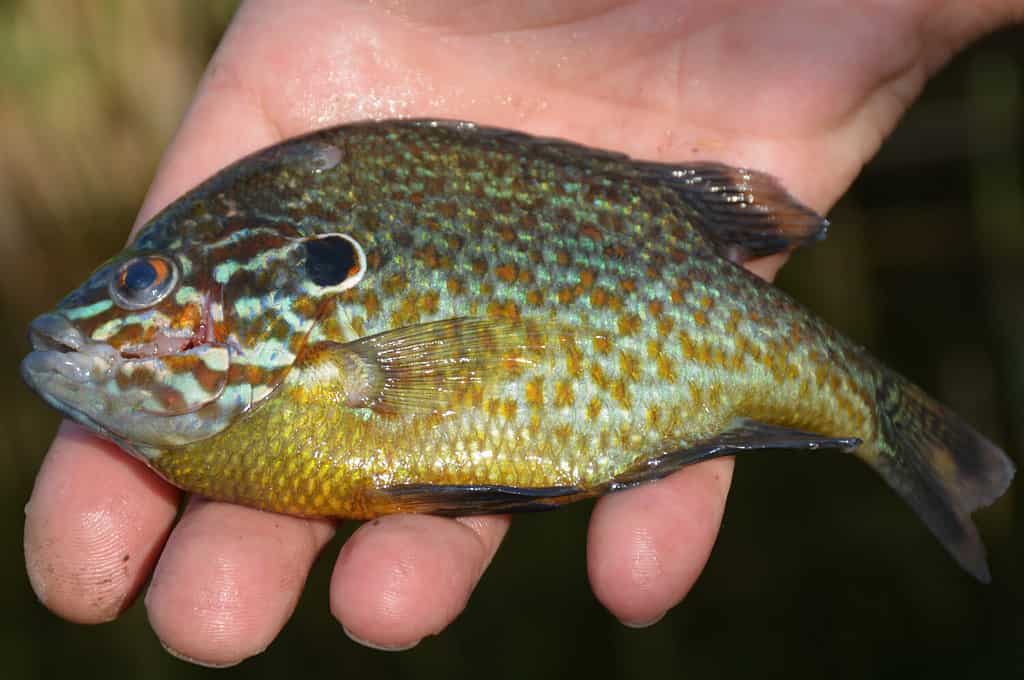
An eye-catching fish you might catch in Lake Lewisville is the longear sunfish.
©Self-taught/Shutterstock.com
The longear sunfish is another fish you could potentially catch in Lake Lewisville.
This fish is quite eye-catching, especially the males, which can come in bright shades of orange or red, along with splashes of turquoise on their heads and fins. Their dorsal and anal fins are pretty much similar in structure to those of redear sunfish.
On average, these fish measure between 5 to 6 inches.
Longear sunfish prefer still waters, typically staying close to areas filled with underwater plants. You won’t find them in strong currents; instead, they’ll be in pools or secluded inlets. These fish are active during the late spring and early summer for mating.
As for their diet, longear sunfish mainly feed near the water’s surface. They primarily consume water insects, tiny crustaceans, and fish eggs — even those of their own species. They also eat juvenile bass and other young sunfish.
12. Longnose Gar (Lepisosteus osseus)

Longnose gar can grow up to 6 feet long!
©Mikhail Blajenov/Shutterstock.com
Not commonly found but still present in Lake Lewisville is the longnose gar.
This fish has a slender, tube-like body that can range in shade from brown to a deep olive color, complemented by a lighter, almost silver belly. Its body is covered in tough, diamond-patterned scales, and it sports dark markings on its back and fins. As evidenced by its name, the fish’s mouth is elongated and filled with sharp teeth.
They can grow quite large, reaching lengths between 5 and 6 feet.
These fish prefer still, slow-moving waters and are often spotted floating near the surface. Younger longnose gars usually stay hidden among underwater plants in quieter backwaters.
When it comes to food, they aren’t picky; their diet includes small fish such as perch and sunfish, as well as various small crustaceans.
13. Hybrid Striped Bass (Morone chrysops x Morone saxatilis)
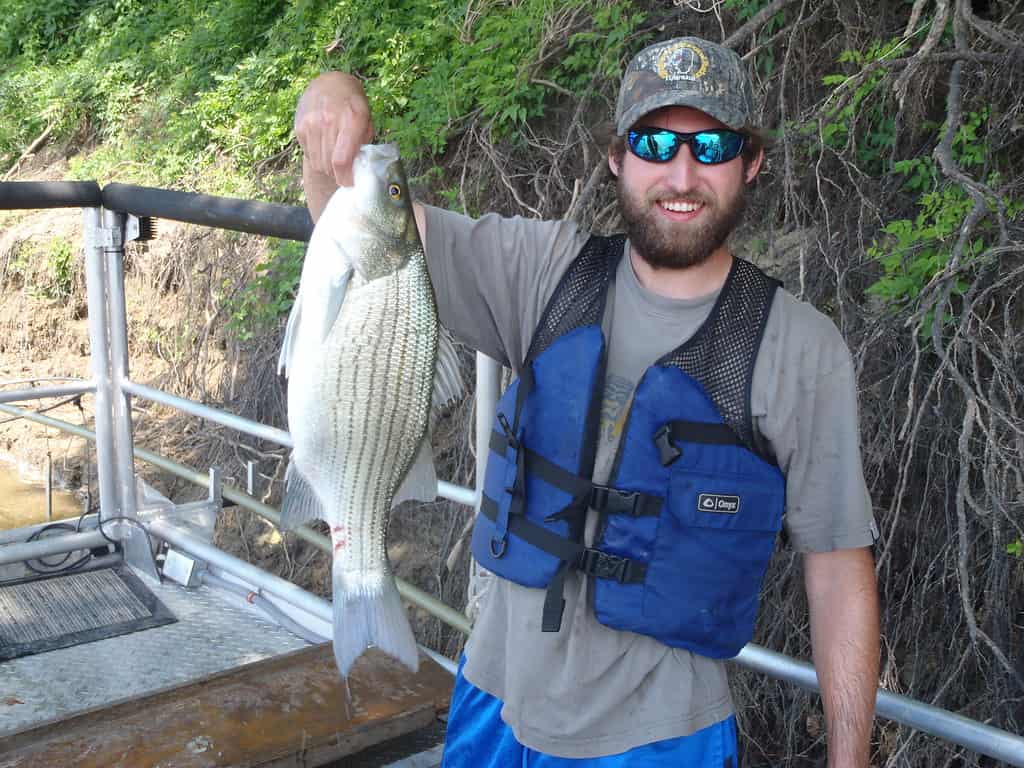
Another abundant fish species in Lake Lewisville is the hybrid striped bass.
©USFWSmidwest / Public domain – License
Hybrid striped bass are abundant in Lake Lewisville, so you will have no problem catching this fish!
This fish has a unique appearance that combines features from its parent species, the striped bass and the white bass. While it has lines like a striped bass, it often appears fragmented, especially around the side fins.
Adults usually measure between 15 and 20 inches in length.
These fish are more tolerant of warmer waters, thanks to their white bass lineage, and they prefer the slow currents of lakes, large ponds, and reservoirs over shallow areas.
Their diet is quite varied, consisting mainly of smaller fish like crappie, bluegill, and shad, with threadfin and gizzard shad being their primary sources of food.
14. Spotted Gar (Lepisosteus oculatus)

Though not very common, you might be able to catch a spotted gar.
©volkova natalia/Shutterstock.com
Spotted gar are less frequently found in Lake Lewisville compared to other fish on the list.
This fish has a brown or olive coloration on top, and its sides are a silver-white color. Both young and adult spotted gar have unique patterns of dark spots across their head, body, and fins, helping them blend into their surroundings.
Adults can grow up to 3 feet in length.
They like calm, clear waters with plenty of plants, typically found in streams, marshy areas, and lakes. These fish are night hunters who mostly eat crayfish, lying in wait under floating debris or thick water plants. Besides crayfish, they also consume a range of fish, including sunfish, shad, and catfish.
15. Striped Bass (Morone saxatilis)
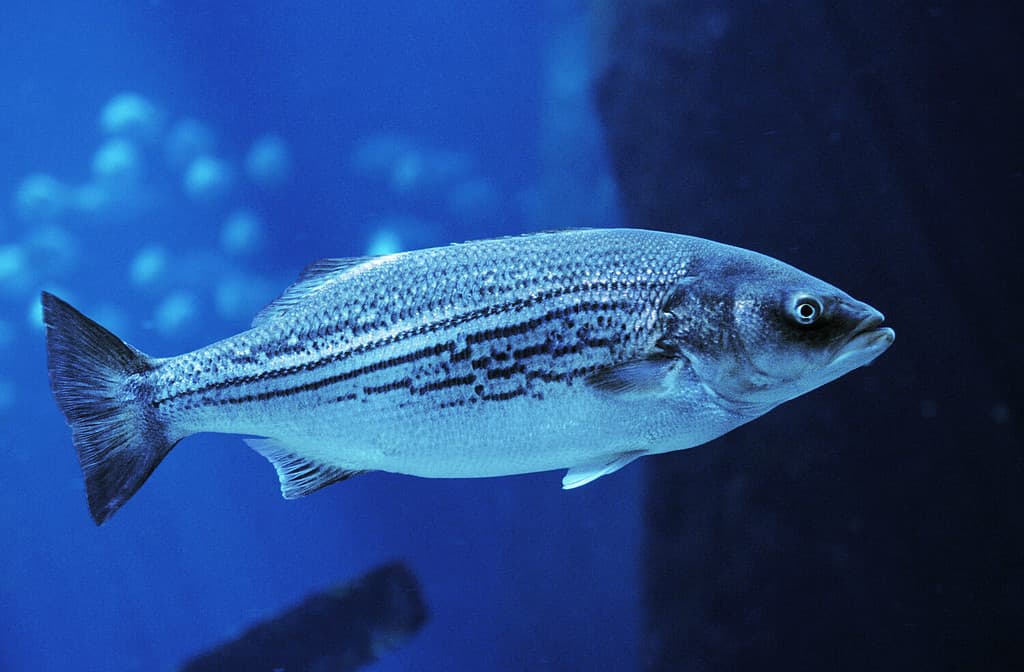
Striped bass are relatively common in Lake Lewisville.
©slowmotiongli/Shutterstock.com
One of the more frequently caught fish in Lake Lewisville is the striped bass.
This fish is robust and features seven to eight unbroken horizontal lines running from behind its gills to its tail. Its color ranges from light green or olive to dark blue or brown on top, while its belly shines white or silver.
Adults of this species can reach lengths of up to 5 feet.
These fish are usually found in areas where shallow waters meet deeper zones, like sandbars or points jutting into the lake. In the early stages, striped bass feed on microscopic creatures. As they grow, their diet expands to include insect larvae and small shellfish, and fully-grown striped bass primarily eat other fish, along with crabs and squid.
Summary of the Fish You Might Catch in Texas’s Lake Lewisville
| Number | Fish | Scientific Name |
|---|---|---|
| 1. | Blue Catfish | Ictalurus furcatus |
| 2. | Kelp Bass | Paralabrax clathratus |
| 3. | Largemouth Bass | Micropterus salmoides |
| 4. | White Bass | Morone chrysops |
| 5. | Black Crappie | Pomoxis nigromaculatus |
| 6. | Spotted Bass | Micropterus punctulatus |
| 7. | Channel Catfish | Ictalurus punctatus |
| 8. | Flathead Catfish | Pylodictis olivaris |
| 9. | White Crappie | Pomoxis annularis |
| 10. | Bluegill | Lepomis macrochirus |
| 11. | Longear Sunfish | Lepomis megalotis |
| 12. | Longnose Gar | Lepisosteus osseus |
| 13. | Hybrid Striped Bass | Morone chrysops x Morone saxatilis |
| 14. | Spotted Gar | Lepisosteus oculatus |
| 15. | Striped Bass | Morone saxatilis |
The photo featured at the top of this post is © Gilberto Villasana/iStock via Getty Images
Thank you for reading! Have some feedback for us? Contact the AZ Animals editorial team.






